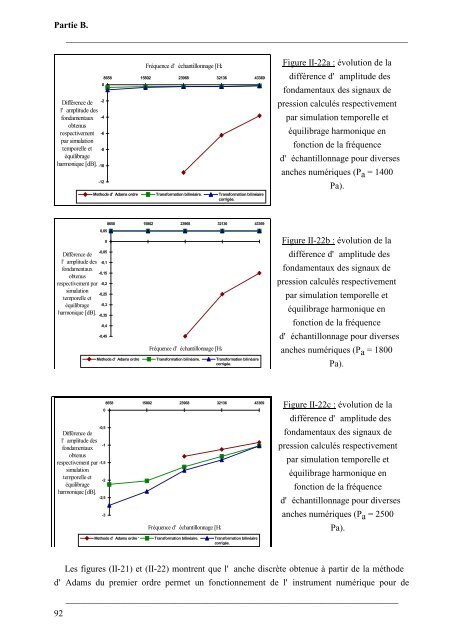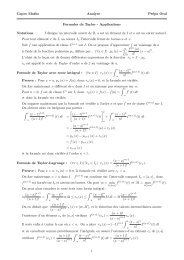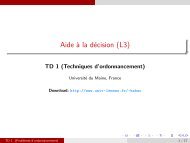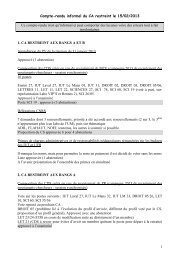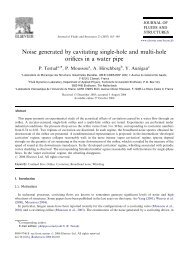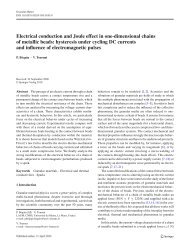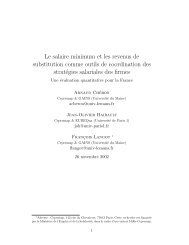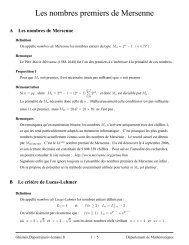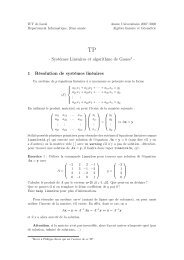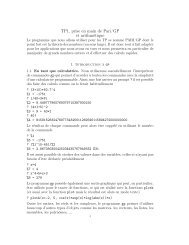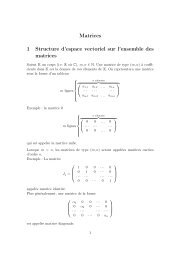Caractérisation objective de la qualité de justesse, de timbre et d ...
Caractérisation objective de la qualité de justesse, de timbre et d ...
Caractérisation objective de la qualité de justesse, de timbre et d ...
- No tags were found...
You also want an ePaper? Increase the reach of your titles
YUMPU automatically turns print PDFs into web optimized ePapers that Google loves.
Partie B.___________________________________________________________________________Différence <strong>de</strong>l' amplitu<strong>de</strong> <strong>de</strong>sfondamentauxobtenusrespectivementpar simu<strong>la</strong>tiontemporelle <strong>et</strong>équilibrageharmonique [dB].0-2-4-6-8-10-12Fréquence d' échantillonnage [Hz]8658 15802 23968 32136 43369M<strong>et</strong>ho<strong>de</strong> d' Adams ordre 1 Transformation bilinéaire. Transformation bilinéairecorrigée.Figure II-22a : évolution <strong>de</strong> <strong>la</strong>différence d' amplitu<strong>de</strong> <strong>de</strong>sfondamentaux <strong>de</strong>s signaux <strong>de</strong>pression calculés respectivementpar simu<strong>la</strong>tion temporelle <strong>et</strong>équilibrage harmonique enfonction <strong>de</strong> <strong>la</strong> fréquenced' échantillonnage pour diversesanches numériques (Pa = 1400Pa).Différence <strong>de</strong>l' amplitu<strong>de</strong> <strong>de</strong>sfondamentauxobtenusrespectivement parsimu<strong>la</strong>tiontemporelle <strong>et</strong>équilibrageharmonique [dB].0,050-0,05-0,1-0,15-0,2-0,25-0,3-0,35-0,4-0,458658 15802 23968 32136 43369Fréquence d' échantillonnage [Hz]M<strong>et</strong>ho<strong>de</strong> d' Adams ordre 1 Transformation bilinéaire. Transformation bilinéairecorrigée.Figure II-22b : évolution <strong>de</strong> <strong>la</strong>différence d' amplitu<strong>de</strong> <strong>de</strong>sfondamentaux <strong>de</strong>s signaux <strong>de</strong>pression calculés respectivementpar simu<strong>la</strong>tion temporelle <strong>et</strong>équilibrage harmonique enfonction <strong>de</strong> <strong>la</strong> fréquenced' échantillonnage pour diversesanches numériques (Pa = 1800Pa).Différence <strong>de</strong>l' amplitu<strong>de</strong> <strong>de</strong>sfondamentauxobtenusrespectivement parsimu<strong>la</strong>tiontemporelle <strong>et</strong>équilibrageharmonique [dB].0-0,5-1-1,5-2-2,5-38658 15802 23968 32136 43369Fréquence d' échantillonnage [Hz]M<strong>et</strong>ho<strong>de</strong> d' Adams ordre 1 Transformation bilinéaire. Transformation bilinéairecorrigée.Figure II-22c : évolution <strong>de</strong> <strong>la</strong>différence d' amplitu<strong>de</strong> <strong>de</strong>sfondamentaux <strong>de</strong>s signaux <strong>de</strong>pression calculés respectivementpar simu<strong>la</strong>tion temporelle <strong>et</strong>équilibrage harmonique enfonction <strong>de</strong> <strong>la</strong> fréquenced' échantillonnage pour diversesanches numériques (Pa = 2500Pa).Les figures (II-21) <strong>et</strong> (II-22) montrent que l' anche discrète obtenue à partir <strong>de</strong> <strong>la</strong> métho<strong>de</strong>d' Adams du premier ordre perm<strong>et</strong> un fonctionnement <strong>de</strong> l' instrument numérique pour <strong>de</strong>_________________________________________________________________________92


